
Catalog excerpts

A Seldén furling mast lets you operate your mainsail from the cockpit, simply and easily. Its unique features for redu ing friction and initial sail c resistance make furling and reefing child’s play. And it also makes sailing safer and far easier for you and your crew.
Open the catalog to page 1
FURLING MASTS manual and electric drive The benefits of furling masts Furling masts, manual Furling masts, electric drive Furling mast specification For hydraulic furling masts, see page 118. With a powered furling mast and a powered Furlex jib furler it is even easier to set, reef and handle your sails. You can work your sails single handed, without leaving the helm. Powered systems are available for yachts ranging from 35 to 70 feet.
Open the catalog to page 2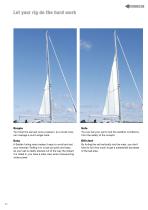
Let your rig do the hard work Simple You hoist the sail just once a season, so a small crew can manage a much larger boat. You can set your sail to suit the wea her conditions, t from the safety of the cockpit. A Seldén furling mast makes it easy to unroll and set your mainsail. Rolling it in is just as quick and easy. As your sail is neatly stowed out of the way the instant it is rolled in, you have a clear view when manoeuvring under power. By furling the sail vertically into the mast, you don’t have to furl very much to get a substantial decrease of the sail area
Open the catalog to page 3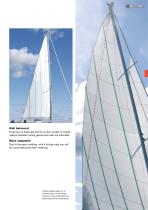
Well balanced There are no fixed reef points, so the number of combinations between furling genoa and main are unlimited. More enjoyable Due to the easy handling, with a furling mast you will do more sailing and less motoring. Vertical battens allow for a positive roach on the furling mainsail. A fine combination of performance and convenience.
Open the catalog to page 4
Cable conduits Guide flange The sail slot is wide and asymmetrically located to reduce friction between the mast and the sail The Seldén furling principle The wide sail slot allows for vertical battens and a positive roach of the main sail. The actual sail slot is placed asymmetrically to reduce furling resistance and to lead the sail straight on to the internal luff extrusion. Cross-section of a Seldén furling mast. The furling system is based on Seldén’s proven technology. Geared line driver winch, tensioned luff extrusion, asymmetrically located sail slot and the patented load...
Open the catalog to page 5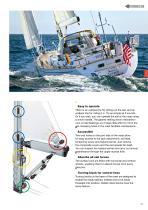
There is an outhaul line for rolling out the sail, and an endless line for rolling it in. It’s as simple as it sounds. Or if you wish, you can operate the sail at the mast using a winch handle. The geared reefing winch mechanism runs on ball bearings, so it takes little effort to roll in the sail. Greasing holes in the mast facilitate maintenance. Two oval holes on the port side of the mast allow for easy access to the tack attachment, sail feed, tensioning screw and halyard swivel. Just remove the composite covers and the rest speaks for itself. You can inspect the halyard swivel and carry...
Open the catalog to page 6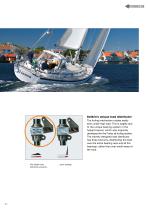
Seldén’s unique load distributor The furling mechanism rotates easily even under high load. This is largely due to the unique bearing system in the halyard swivel, which was originally developed for the Furlex jib furling system. The cleverly designed load distributor has three fulcrums, distributing the load over the entire bearing race and all the bearings, rather than over small areas of the race. The Seldén load distributor prevents…
Open the catalog to page 7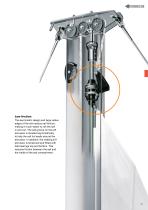
Low friction The asymmetric design and large radius edges of the slot reduce sail friction, making it much easier to roll the sail in and out. The sail groove on the luff extrusion is located asymmetrically to help the sail furl easily around the extrusion. In addition, the rotating luff extrusion is tensioned and fitted with ball bearings top and bottom. This reduces friction between the sail and the inside of the sail com artment. p
Open the catalog to page 8All Forwater catalogs and brochures
-
4WATER 2014 PERSONAL SAFETY
66 Pages
Archived catalogs
-
LITHIUM LIFE BUOY LIGHT
1 Pages
-
SOLAS LIFE JACKET LIGHT
1 Pages





